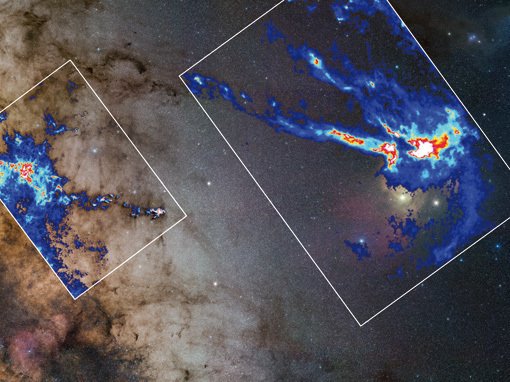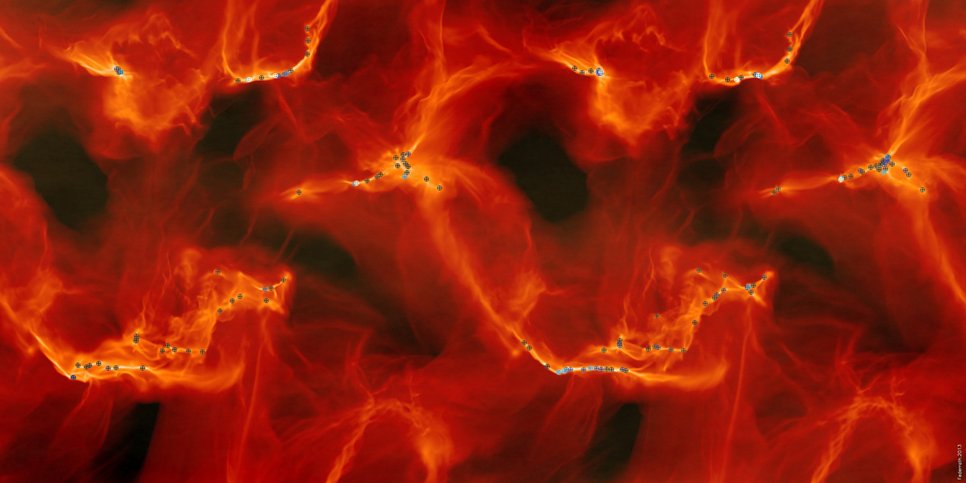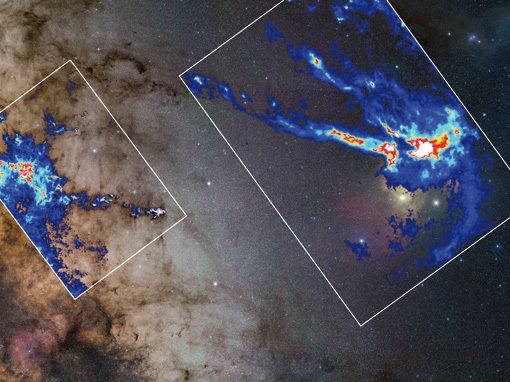Finding the "Recipe for Star Formation"
Astronomers have found a new way of predicting the rate at which a molecular cloud – a stellar nursery – will form new stars. Using a novel technique to reconstruct a cloud's three-dimensional structure, the astronomers can estimate how many new stars the cloud is likely to form. The newfound "recipe" allows for direct tests of current theories of star formation. It will also enable telescopes such as the Atacama Large Millimetre/Submillimetre Array (ALMA) to estimate the star-formation activity in more distant molecular clouds, and thus to create a map of star births within our home galaxy. The results will be published in the April 11, 2014 edition of the journal Science.

Star formation is one of the fundamental processes in the universe – how stars form, and under what conditions, shapes the structure of entire galaxies. Stars form within giant clouds of interstellar gas and dust. As a sufficiently dense region within such a molecular cloud collapses under its own gravity, it contracts until the pressure and the temperature inside are high enough for nuclear fusion to set in, signaling the birth of a star.
Measuring star formation rates is extremely challenging, even throughout our home galaxy, the Milky Way. Only for nearby clouds, up to distances of about 1500 light-years, are such measurements fairly straightforward: You simply count the young stars within that cloud. For more distant clouds, where it is impossible to discern individual stars, this technique fails, and star formation rates have remained uncertain.
Recently three astronomers, Jouni Kainulainen and Thomas Henning from the Max Planck Institute for Astronomy in Germany, and Christoph Federrath from Monash University in Australia, have found an alternative way of determining star formation rates: a "recipe for star formation," which links direct astronomical observations of the structure of a giant gas cloud to its star formation activity.
The astronomers arrived at their result by modelling the three-dimensional structure of individual clouds in a simplified way. The data they use comes from an astronomical version of a medical X-raying procedure: As the light of distant stars shines through a cloud, it is dimmed by the cloud's dust. The dimming of tens of thousands of different stars forms the basis of the three-dimensional reconstruction, which in turn shows the matter density for various regions within the cloud.
For nearby clouds, Kainulainen and his colleagues compared their reconstruction and direct observations of how many new stars had recently formed in these clouds. In this way, they were able to identify a "critical density" of 5000 hydrogen molecules per cubic centimeter, and showed that only regions exceeding this critical density can collapse to form stars.
Kainulainen explains: "This is the first time anyone has determined a critical density for forming stars from observations of cloud structure. Theories of star formation have long predicted the importance of such a critical density. But our reconstruction technique is the first to allow astronomers to deduce the density structure of these clouds – and to confront star formation theories with observational data."

Abbildung 2: Computersimulation der Sternentstehung in einer turbulenten Gaswolke. Diese und ähnliche Simulationen benutzten Kainulainen und seine Kollegen, um ihre Methode zur Rekonstruktion der räumliche Struktur solcher Gaswolken zu testen. Orte, an denen gerade neue Sterne entstehen, sind in der Abbildung durch Kreise gekennzeichnet; eine hellere Farbe entspricht dabei massereicheren Sternen.
Christoph Federrath, who provided the numerical simulations that were used to test the new technique, adds: "With these results and the tools we developed to test theories of star formation, we can even hope to tackle one of the greatest unanswered questions of astrophysics: If stars form within a cloud of a given mass, how many stars with what kind of mass can you expect?"
Thomas Henning, director at the Max Planck Institute for Astronomy and co-author of the study, adds: "There are many observations of molecular clouds – and with the advent of ALMA, much more precise data for more distant clouds will become available. With our technique, we're able to say: Show us your data, and we will tell you how many stars your cloud is forming right now."
ALMA is an array of 66 high-precision microwave antennas, spread over distances of up to 16 kilometers in the Chilean desert, and able to act as a single, high-resolution telescope. ALMA has just commenced operations, and can detect clouds of gas and dust with unprecedented sensitivity, and in more detail than ever before.
Kainulainen concludes: "We've handed astronomers a potent new tool. Star formation is one of the most fundamental processes in astronomy – and our results allow astronomers to determine star formation rates for more clouds than ever before, both within our own galaxy and in distant other galaxies."
Background information
The new results have been published as Jouni Kainulainen, Christoph Federrath and Thomas Henning: "Unfolding the Laws of Star Formation: The Density Distribution of Molecular Clouds" in the April 11, 2014 edition of the journal Science.
Jouni Kainulainen acknowledges support from Deutsche Forschungsgemeinschaft priority program 1573 ("ISM-SPP"), and Christoph Federrath a Discovery Projects Fellowship from the Australian Research Council (grant DP110102191).
A copy of the paper can be found online at the Science press package at http://www.eurekalert.org/jrnls/sci. You will need your Eurekalert user ID and password to access this information.
Questions and Answers
What is new/important about this result?
Previously, observations of cloud structure were disconnected from the theory of star formation in these clouds. Star formation models talked about densities. Observational astronomers produced two-dimensional emission maps (of light emitted by dust or molecules in those clouds) or absorption maps (of light from a distant star that is dimmed as it passes through the cloud) in the plane of the sky. The new reconstruction technique presented here brings observations and theory together much more directly than previous estimates, as it directly reconstructs a cloud's density structure from the available data. Application of this technique to nearby clouds (distance less than about 1000 light-years) shows that, as theorists had long predicted, there is a critical density below which gas cannot collapse to form a star, and gives a direct estimate of 5000 hydrogen molecules per cubic centimeter for that critical density.
As described in the main text, once this kind of reconstruction is possible, observational data from telescopes such as ALMA can be put to even better use than before, namely to estimating star formation rates in distant molecular clouds whose star formation activity cannot be deduced by other means. ALMA examines these clouds not by observing the dimming of stars, but by receiving radiation from the dust contained within the clouds.
How does the three-dimensional reconstruction technique work?
As the light from distant stars passes through a molecular cloud on its way to Earth, some of it is absorbed and scattered. The resulting dimming of the light can be plotted as a map, which shows how much matter the light has traversed in each part of the cloud ("column density"). To this dimming map, Kainulainen and his colleagues fitted a simple three-dimensional structure made up of simple shapes: longish or less longish cigar-shaped regions of space ("prolate ellipsoids"). As a simplification, these cigars are assumed to be oriented at right angles to the line of sight. In a comparison with computer simulations, the astronomers showed that, even with this simplification, the reconstruction yields a good estimate for the three-dimensional structure – for a decomposition of the cloud into regions of different size and with different densities.
Download area




